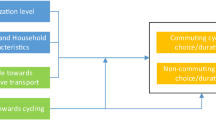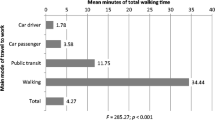Abstract
This study aims to establish whether or not bicycle commuting and cycling for other purposes (e.g. shopping, visiting friends) are related over time. Using previously gathered panel data (the Dutch mobility panel) these relationships are revealed by (1) a series of conditional change models and (2) a latent transition model. The conditional change models indicate that, with a lag of 1 year and controlling for a range of background characteristics, bicycle commuting and non-work cycling (in number of weekly trips) have a positive reciprocal influence on each other. The models show that work-related factors, such as the distance to work or whether a person receives a travel allowance, affect not only bicycle commuting but also non-work cycling. The latent transition model indicates that people can be clustered into four groups: non-cyclists, non-work cyclists, all-around cyclists and commuter cyclists. This model shows that people with a consistent propensity to not cycle at all (non-cyclists) or to cycle for both work and non-work purposes (all-around cyclists) are most stable in their travel behavior. Non-work cyclists and commuter cyclists are less stable in travel behavior. The model also shows that all-around cyclists are not (significantly) affected by a change in the distance to work. The article concludes with several directions for future research.



Similar content being viewed by others
Notes
Bicycle trips for employers’ business which represent a very small portion of all bicycle trips in the Netherlands (0.3 % in our sample), were not considered in the analysis.
References
Anable, J., Gatersleben, B.: All work and no play? The positive utility of travel for work compared to leisure journeys. Transp. Res. Part A 39(2/3), 163–181 (2005). doi:10.1016/j.tra.2004.09.008
Collins, L.M., Lanza, S.T.: Latent Class and Latent Transition Analysis with Applications in the Social, Behavioral, and Health Sciences. Wiley, Hoboken (2009)
Finkel, S.E.: Causal Analysis with Panel Data. Sage Publications, Thousand Oaks (1995)
Gardner, G.: Transport Implications of Leisure Cycling. Transport Research Laboratory, Crowthorne (1998)
Gatersleben, B., Uzzell, D.: Affective appraisals of the daily commute—comparing perceptions of drivers, cyclists, walkers, and users of public transport. Environ. Behav. 39(3), 416–431 (2007). doi:10.1177/0013916506294032
Golob, T.F., Van Wissen, L.: A joint household travel distance generation and car ownership model. Transp. Res B 23(6), 471–491 (1989). doi:10.1016/0191-2615(89)90045-3
Golob, J.M., Schreurs, L.J.M., Smit, J.G. (eds.): The Design and Policy Applications of a Panel for Studying Changes in Mobility Over Time. VNU Press, Utrecht (1985)
Gomez, L., Sarmiento, O., Lucimi, D., Espinosa, G., Forero, R., Bauman, A.: Prevalence and factors associated with walking and bicycling for transport among young adults in two low-income localities of Bogotá, Colombia. J. Phys. Act. Health 2, 445–449 (2005)
Heinen, E., Maat, K., Van Wee, B.: The effect of work-related factors on the bicycle commute mode choice in the Netherlands. Transportation, 1–21 (2012). doi:10.1007/s11116-012-9399-4
Jarvis, C.B., MacKenzie, S.B., Podsakoff, P.M.: A critical review of construct indicators and measurement model misspecification in marketing and consumer research. J. Consum. Res. 30(2), 199–218 (2003). doi:10.1086/376806
Lee, I., Park, H., Sohn, K.: Increasing the number of bicycle commuters. Proc. Inst. Civil Eng. Transp. 165(1), 63–72 (2012)
Long, J.S.: Regression Models for Categorical and Limited Dependent Variables. Sage Publications, Thousand Oaks (1997)
Lord, D., Washington, S.P., Ivan, J.N.: Poisson, Poisson-gamma and zero-inflated regression models of motor vehicle crashes: balancing statistical fit and theory. Accid. Anal. Prev. 37(1), 35–46 (2005). doi:10.1016/j.aap.2004.02.004
Magidson, J., Vermunt, J.K.: Latent class models. In: Kaplan, D. (ed.) The Sage Handbook of Quantitative Methodology for the Social Sciences, pp. 175–198. Sage Publications, Thousand Oaks (2004)
McCutcheon, A.L.: Latent Class Analysis. Sage Publications, Newbury Park (1987)
Meurs, H., Van Wissen, L.: Analysis of panel data. Paper presented at the round table conference on the analysis of panel data (1987)
Mokhtarian, P.L., Chen, C.: TTB or not TTB, that is the question: a review and analysis of the empirical literature on travel time (and money) budgets. Transp. Res. Part A 38(9), 643–675 (2004). doi:10.1016/j.tra.2003.12.004
Muthén, B., Asparouhov, T.: LTA in Mplus: Transition probabilities influenced by covariates. http://www.statmodel.com/examples/LTAwebnote.pdf (2011). Accessed 6 Dec 2012
Nylund, K.L.: Latent transition analysis: modeling extensions and an application to peer victimization. Dissertation, University of California (2007)
Ortuzar, J.D., Armoogum, J., Madre, J.L., Potier, F.: Continuous mobility surveys: the state of practice. Transp. Rev. 31(3), 293–312 (2011). doi:10.1080/01441647.2010.510224
Paez, A., Whalen, K.: Enjoyment of commute: a comparison of different transportation modes. Transp. Res. A 44(7), 537–549 (2010). doi:10.1016/j.tra.2010.04.003
Park, H., Lee, Y.J., Shin, H.C., Sohn, K.: Analyzing the time frame for the transition from leisure-cyclist to commuter-cyclist. Transportation 38(2), 305–319 (2011). doi:10.1007/s11116-010-9299-4
Pucher, J., Buehler, R. (eds.): City Cycling. MIT Press, Cambridge (2012)
Pucher, J., Dill, J., Handy, S.: Infrastructure, programs, and policies to increase bicycling: an international review. Prev. Med. 50, S106–S125 (2010). doi:10.1016/j.ypmed.2009.07.028
Sarmiento, O., Torres, A., Jacoby, E., Pratt, M., Schmid, T., Stierling, G.: The Ciclovía-Recreativa: a mass recreational program with looming public health potential. J. Phys. Act. Health 7, S163–S180 (2010)
Stinson, M.A., Bhat, C.R.: Frequency of bicycle commuting Internet-based survey analysis. Transp. Res. Rec. 1878, 122–130 (2004)
Van Beek, P., Geurs, K., Hoogendoorn-Lanser, S.: MobiliteitsPanel Nederland (MPN): achtergrond en opzet. Paper presented at the Colloquium Vervoersplanologisch Speurwerk (2011)
Verplanken, B., Aarts, H.: Habit, attitude, and planned behaviour: is habit an empty construct or an interesting case of goal-directed automaticity? Eur. Rev. Soc. Psychol. 10(1), 101–134 (1999). doi:10.1080/14792779943000035
Verplanken, B., Aarts, H., Van Knippenberg, A., Van Knippenberg, C.: Attitude versus general habit: antecedents of travel mode choice. J. Appl. Soc. Psychol. 24(4), 285–300 (1994)
Xing, Y., Handy, S.L., Mokhtarian, P.L.: Factors associated with proportions and miles of bicycling for transportation and recreation in six small US cities. Transp. Res. D 15(2), 73–81 (2010). doi:10.1016/j.trd.2009.09.004
Acknowledgments
The study was conducted as part of the project “The value of recreation: Now, and in a completely different future”, which is part of the DBR (Duurzame Bereikbaarheid van de Randstad—Sustainable Accessibility of the Randstad) programme. It was financially supported by the Netherlands Organization for Scientific Research (NWO).
Author information
Authors and Affiliations
Corresponding author
Rights and permissions
About this article
Cite this article
Kroesen, M., Handy, S. The relation between bicycle commuting and non-work cycling: results from a mobility panel. Transportation 41, 507–527 (2014). https://doi.org/10.1007/s11116-013-9491-4
Published:
Issue Date:
DOI: https://doi.org/10.1007/s11116-013-9491-4




